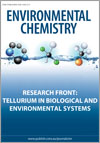
Environmental Chemistry
Volume 16 Number 4 2019
RESEARCH FRONT: Tellurium in Biological and Environmental Systems: After Fukushima
Environmental context. Tellurium, a chemical element increasingly being used in new technologies, is an emerging contaminant. Our understanding of tellurium’s environmental behaviour, however, is poor, with critical knowledge gaps such as its distribution in the various environmental compartments and the environmental fluxes associated with mining, usage and disposal. Significant progress in these areas requires the development of robust analytical methods that are sufficiently sensitive to provide data at environmentally relevant concentrations.
EN18226Tellurium behaviour in a major European fluvial–estuarine system (Gironde, France): fluxes, solid/liquid partitioning and bioaccumulation in wild oysters
 , Jörg Schäfer, Lionel Dutruch, Cécile Bossy, Frédérique Pougnet, Melina Abdou, Antoine Lerat-Hardy, Clément Pereto, Hervé Derriennic, Nicolas Briant, Teddy Sireau, Joël Knoery and Gérard Blanc
, Jörg Schäfer, Lionel Dutruch, Cécile Bossy, Frédérique Pougnet, Melina Abdou, Antoine Lerat-Hardy, Clément Pereto, Hervé Derriennic, Nicolas Briant, Teddy Sireau, Joël Knoery and Gérard Blanc
Environmental context. The environmental behaviour of tellurium is poorly understood. We investigate the transport of tellurium in both dissolved and particulate forms from the river watershed to the Gironde Estuary, where a 30-year historical record provides insight on tellurium bioaccumulation in wild oysters. These results constitute the first comprehensive study on natural tellurium behaviour in a major fluvial-estuarine system, information essential for predictive modelling of tellurium risk assessment.
Environmental context. Studies involving modelling are increasingly being performed to better understand how technology-critical elements such as tellurium are transported and accumulated in man-made technological systems. The resulting ‘anthropogenic cycles’ provide estimates of current and anticipated future material releases to the environment, and their associated environmental implications. This information complements data on natural cycles in which the subsequent transport and fate of tellurium in the environment can be examined.
EN18215Surficial geochemistry and bioaccessibility of tellurium in semiarid mine tailings
Environmental context. Tellurium can be more toxic than arsenic, but its fate in the surficial environment is poorly understood. We studied tellurium behaviour in semiarid mine tailings and found that most tellurium is associated with iron (oxy)hydroxides as tellurate (TeVI), the less toxic oxidation state. Iron (oxy)hydroxides are likely to control the fate of Te in the surficial environment and may effectively sequester Te oxyanions released by oxidative weathering.
EN18215 Abstract | EN18215 Full Text | EN18215PDF (843 KB) Open Access Article
EN18238Tellurite-dependent blackening of bacteria emerges from the dark ages
Environmental context. Although tellurium is a relatively rare element in the earth’s crust, its concentration in some niches can be naturally high owing to unique geology. Tellurium, as the oxyanion, is toxic to prokaryotes, and although prokaryotes have evolved resistance to tellurium, no universal mechanism exists. We review the interaction of tellurite with prokaryotes with a focus on those unique strains that thrive in environments naturally rich in tellurium.
Environmental context. Equilibrium constants are required in many scientific disciplines such as biology, medicine, engineering, and in particular chemistry. Lack of reliable equilibrium constants for tellurium has restricted our understanding of its speciation and behaviour in the environment. This study presents a reliable set of equilibrium constants for tellurium, thereby providing a more coherent basis for future experimental investigations of the geochemistry, biochemistry and toxicology of this element.
EN19054Tellurium radionuclides produced by major accidental events in nuclear power plants
Environmental context. Historical accidents in nuclear power plants have released radionuclides of several elements, including tellurium, to the environment. Although tellurium radionuclides are significant radioactive emission products, and show medium-term persistence in the environment, the mechanisms behind their widespread dispersion are unknown. Future research into the biogeochemical behaviour of stable tellurium is proposed as an appropriate approach to develop tellurium dispersion scenarios fundamental for post-accident management.



